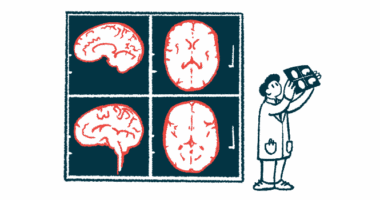#ACTRIMS2021 – Long-term Uplizna Reduces NMOSD Attacks, Trial Data Show

Long-term treatment with Uplizna (inebilizumab-cdon) is safe and sustainably reduces the frequency of attacks in adults with neuromyelitis optica spectrum disorder (NMOSD), according to four-year data from the N-MOmentum Phase 2/3 clinical trial.
Notably, these benefits also were observed among patients who previously received rituximab, an immunosuppressive therapy often used off-label in this patient population. While both Uplizna and rituximab target B-cells, immune cells involved in NMOSD attacks, they do so through different mechanisms.
The findings support the profound and sustained effects of Uplizna in NMOSD patients.
“Uplizna demonstrated strong safety and efficacy during the open-label extension for a period of four years, regardless of the patient’s previous treatment with off-label therapy, further supporting the [therapy]’s ability to provide long-term therapeutic benefits to patients with NMOSD,” Jörn Drappa, MD, PhD, said in a press release. Drappa is chief medical officer of Viela Bio, the therapy’s developer.
These and other findings from the N-MOmentum study were presented through four posters at the virtual Americas Committee for Treatment and Research in Multiple Sclerosis (ACTRIMS) Forum 2021.
NMOSD is an autoimmune disease in which the immune system wrongly produces antibodies that attack astrocytes and oligodendrocytes — cells that support the nervous system — and cause inflammation in the optic nerve and spinal cord.
Most NMOSD patients have high levels of antibodies against the protein aquaporin-4 (AQP4) in astrocytes, while some have antibodies against myelin oligodendrocyte glycoprotein (MOG).
In June 2020, Uplizna was approved in the U.S. as a treatment for adults with NMOSD who test positive for anti-AQP4 antibodies. The therapy is given directly into the bloodstream twice a year.
Uplizna works by targeting CD19, a protein found at the surface of B-cells — the immune cells that make antibodies against AQP4, MOG, and others — and leading to their death, thereby lowering antibody production. As such, the therapy is expected to reduce the risk of NMOSD attacks.
Uplizna’s approval was based on results from the N-MOmentum Phase 2/3 trial (NCT02200770), the largest randomized, placebo-controlled study in NMOSD. It evaluated the safety and effectiveness of Uplizna in 230 adults with NMOSD, who were assigned randomly to receive either Uplizna (174 patients) or a placebo (56 patients) on days 1 and 15.
More than 92% of patients were positive for anti-AQP4 antibodies.
Participants were followed for about 6.5 months, after which 216 of them (more than 90% from each group) choose to enter the trial’s open-label portion, in which all are receiving Uplizna every six months for up to three years after the last patient entered this part.
Data from the randomized part of the trial showed that the study met its main goal, with a significantly smaller proportion of Uplizna-treated patients experiencing an attack over the 197 days of follow-up, compared with those on a placebo (12% vs. 39%). This represented a 72.8% lower risk of attack.
In the poster “The N-MOmentum Trial of Inebilizumab for Neuromyelitis Optica Spectrum Disorder: Long-Term Open Label Efficacy and Safety Update,” Bruce Cree, MD, PhD, lead investigator for N-MOmentum revealed Uplizna’s safety and effectiveness data during the study’s open-label part.
Results showed that up to four years of treatment with Uplizna resulted in sustained, low attack rates, with 87.7% of patients on Uplizna since the study began and 83.4% of those assigned initially to placebo remaining attack-free.
Notably, the proportion of patients with no attacks was greater than 90% at six months and one year among patients who always received Uplizna during the trial.
When considering all participants who ever received a dose of Uplizna during the whole trial, 80% of them remained attack-free after four years.
In addition, long-term Uplizna treatment was not associated with new safety concerns, and the most common adverse events (side effects) were consistent with those reported during the randomized part of the trial. The most frequently reported side effects were urinary tract infections (17.6% in the always-on-Uplizna group vs. 37.3% in the placebo-to-Uplizna group) and common cold (17% vs. 17.6%).
Long-term treatment also was not linked to higher rates of infections and serious infections. Of note, since B-cells are involved in the fight against microbes and infections, B-cell depletion associated with Uplizna and other B-cell targeting-therapies may increase the risk of infections.
Two participants died: one from complications of a severe NMOSD attack, and the other from a central nervous system event of unclear cause.
A second poster, “The Safety And Efficacy Of Inebilizumab In Those With Previous Rituximab Exposure,” was presented by Michael Levy, MD, PhD, a researcher at Viela Bio (now part of Horizon Therapeutics). It provided safety and effectiveness data on the 17 trial participants (7.4%) who had been treated previously with rituximab, a B-cell-targeting therapy frequently used off-label for NMOSD.
Their mean age was 46 years, and most were women (94%) and positive for antibodies against AQP4 (94%). At study entry, these patients had received their last dose of rituximab a median of 1.5 years before. A total of 13 participants were assigned initially to Uplizna and three to a placebo.
Results showed that three of these patients (two assigned initially to placebo) experienced an NMOSD attack while on Uplizna: one in the randomized part of the trial, and two during its open-label phase.
Compared with the rest of Uplizna-treated patients, prior rituximab treatment did not affect Uplizna’s efficacy, with an annualized attack rate of 0.083 for those on prior rituximab and 0.102 for those who did not receive rituximab.
At a median of 2.6 years of follow-up, none of the seven patients (41%) experiencing an attack while on previous rituximab or within six months of the last dose had an attack after receiving Uplizna.
A higher proportion of participants who were taking rituximab previously reported infections, compared with those who never received the off-label therapy (96% vs. 70%).





